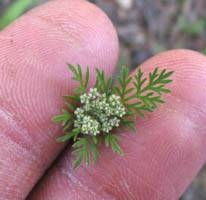American wild carrot facts for kids
Quick facts for kids American wild carrot |
|
|---|---|
 |
|
| Scientific classification | |
| Genus: |
Daucus
|
| Species: |
pusillus
|
| Synonyms | |
|
|
Daucus pusillus is a type of wild carrot often called the American wild carrot or rattle-snake-weed. Its scientific name, Daucus pusillus, means "little carrot" or "tiny carrot" in Latin. This plant looks a lot like other wild carrots. It has clusters of small white or sometimes pinkish flowers that form a shape like an umbrella.
Contents
American Wild Carrot: A Tiny Root
What Does the American Wild Carrot Look Like?
The American wild carrot looks very similar to other types of wild carrots. It grows small flowers grouped together in a special shape called an umbel. An umbel looks like an umbrella, with many flower stalks coming from one point. These flowers are usually white, but sometimes they can have a pinkish color.
The plant also has a taproot. This is a main root that grows straight down into the ground. For Daucus pusillus, these taproots are quite small.
Where Can You Find This Plant?
This plant is common in many parts of North America. You can find it in the southern United States. It also grows along the west coast, all the way from Baja California in Mexico up to British Columbia in Canada. For example, in Baja California, it often grows near other plants like Mimulus aridus and Adiantum jordanii.
Is the American Wild Carrot Edible?
Yes, the small taproots of the American wild carrot can be eaten. They are like tiny carrots.
Important Safety Warning: It is very important not to confuse Daucus pusillus with a plant called Conium maculatum, which is also known as poison hemlock. Poison hemlock is extremely dangerous and can be deadly if eaten. Always be sure you know exactly what plant you are picking before you ever try to eat it. It's best to only eat plants identified by an expert.
See Also


